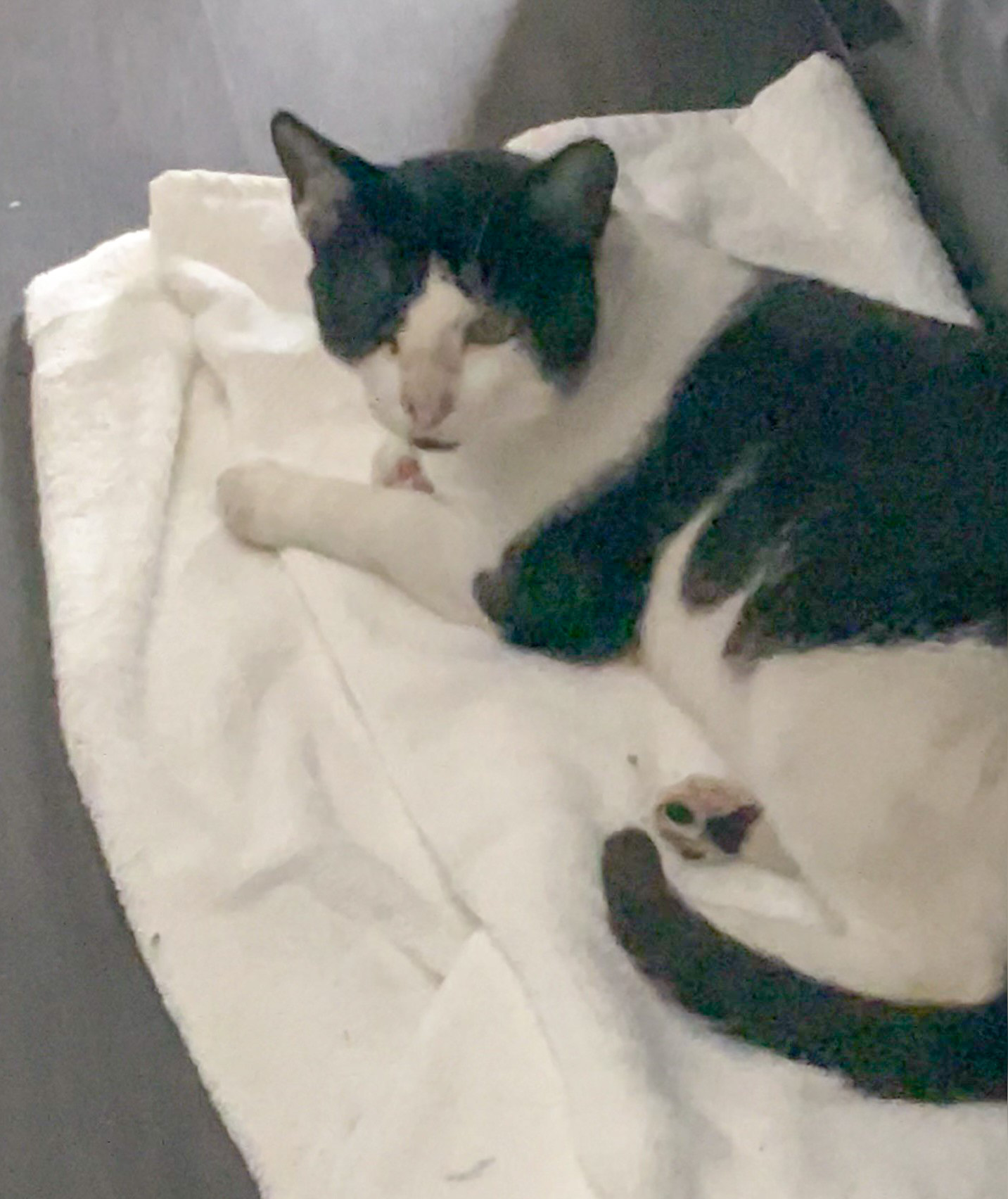Cat drama sheds light on rescue policies
A pre-hurricane drama over a motel-visiting cat in Carrabelle has brought into sharper focus the role played by officials responsible for compassion over, and control of, the Forgotten Coast’s feline population.
It all started in the days before Hurricane Helene was set to pounce on Gulf and Franklin counties, when Amelia Steenmeyer, an information technology consultant from Niceville, found herself staying at a motel in Carrabelle as she pondered relocating her company here.
Beginning with her regular visits here in June, she had befriended a cat that came by and over time stepped up her interactions to the point where she fed the cat regularly, invited it into her room and paid the additional fee required to have an animal in her room.
“He enjoyed being at my feet while I was on the computer,” said Steenmeyer. “I spent well over three months feeding this amazing cat. talking about him from Carrabelle to Washington state nearly daily.
“Those at the hotel in Carrabelle knew me well for many months, and knew that I would drive daily and feed him. I even gave them food and a food container to eat from,” she said. “They had my number and instructions to contact me; I would be there the same day if anything happened to him!”
As the storm approached, Steenmeyer chose to relocate to safer ground, and then returned after Helene had passed, going to the motel to check on the status of her beloved animal.
But, she soon learned, the motel had called authorities and had the cat removed from the premises. When she later checked on the animal’s status, she soon discovered that it had been put down by animal control.
Or had it?
To sort out what happened, it is important to note that in Franklin County, there are two distinct and separate entities, the animal control arm of the county government whose job it is to control the population of loose, feral and wild animals that often pose a threat to the welfare of the human population.
And there is the Franklin County Humane Society, a non-profit organization at a separate location whose role it is to house and eventually adopt out “furry friends” and in doing so to maintain its no-kill status as a shelter that euthanizes only a very small percentage of its pet population, and only for either terminal illness or for an aggressive temperament that makes it unadoptable.
In Gulf County, the St. Joseph Bay Humane Society is also separate from Gulf County animal control, but the housing facility is located at the same site, and the two work closely together, just as they do in Franklin
“We were never contacted by animal control or anyone else until after the fact,” said Karen Martin, director of the Franklin County Humane Society. “We were not in the loop and I explained that we are separate entities.”
Had they been contacted, Martin said they would have carefully weighed whether they could accept the cat. “If I have space, the answer is yes, as long as it is friendly and not a feral,” she said. “If I am at capacity, I can’t intake the cat because I have no place to put the cat.”
The key here is whether it was feral.
Katie Graham, office manager at the St. Joseph Bay Humane Society, said the Gulf County facility is usually able to adopt out such wild, free-ranging cats because there are plenty of farms and rural settings that are willing to take on such felines as barn cats or outdoor cats for their premises.
But in Franklin, options are more limited.
“If a cat is a threat and will cause bodily harm, then unfortunately I can’t intake the cat,” Martin said. “I can’t be responsible for a cat that will hurt a person. That has to be our priority.”
In the event the cat is accepted, it is either adopted directly from the Eastpoint shelter, or transferred to one of its shelter partners, usually to a larger metro area where there are more adopters available.
“The only time we euthanize a cat after drop off is if the cat has a contagious disease and it will typically get sick relatively soon,” Martin said.
In the case of animal control, it’s a different story.
The law clearly states that “feral or un-weaned animals may be euthanized immediately upon impoundment,” unlike animals that appear domesticated, in which there is a notification effort made and a waiting period observed before any action is taken.
Fonda Davis, head of the Franklin County animal control, said that the motel owner had told the officer that “they do not want cats because of the potential liability.”
He said Steenmeyer contacted animal control at least nine days after the cat had been picked up, and then complained that the county was defying its status as a “no kill county,” which is a title usually reserved for humane societies and not one that the county has ever claimed to have.
Davis said she was in fact told that the cat had been euthanized, but as it turned out, the individual answering the phone had gotten it wrong.
“Normally we would have taken it to the humane society for adoption but they don’t even take the feral cats,” he said.
So instead, the compassionate, but somewhat rulebreaking animal control officer took it upon himself to release the cat.
“The cat was in too good a shape so he released it,” Davis said. “He let the cat go in another area.”
The department head noted that the officer was chastised (presumably gently), for breaking the rules.
So the question remains, what exactly is a feral cat?
Keegan Spera, disaster assessment coordinator and data specialist at the University of Florida Shelter Medicine Program, said it is important to note that since cats often roam freely, a feral cat is defined more by its behavior than by its living conditions.
“They are basically wild animals,” she said. “They have never been socialized to humans, even when being fed. They would suffer in a house. But they do fine in a community if they are fixed and vaccinated and have a steady source of food.”
In contrast, there are lots of outdoor cats known as “community cats” which live in colonies. These are the sort of cats that St. George Island Cat Allies, a non-profit group dedicated to neutering, trapping and releasing back into the wild, can relocate to a colony when they are unadoptable.
“A stray cat is a cat who lived indoors and was socialized to people at some point in her life, but has left or lost her home, or was abandoned, and no longer has regular human contact,” reads an article from a cat ally group referred to by Spera. “Over time, a stray cat can become feral as her contact with humans dwindles. A stray cat may be socialized enough to allow people to touch her, but she will become less socialized, or even closer to feral, if she spends too much time without positive interaction with humans.
“Under the right circumstances, a stray cat can also become a pet cat once again. Stray cats that are re-introduced to an indoor home after living outdoors may require a period of time to re-acclimate; they may be frightened and wary after spending time outside away from people,” it reads.
While feral cats are usually fearful of people and unlikely to ever become a lap cat or enjoy living indoors, kittens born to feral cats can be socialized at an early age and adopted into indoor homes, reads the article .
Spera said that while municipal shelters usually have a greater array of adoptable homes, the supply of such homes is limited in Gulf and Franklin counties. “One of the most important things to advocate for is more funding for rural counties to support their animals,” she said. “Especially in the Big Bend, it is very limited.”
Spera said she was pleased with how well she was able to work with the shelters on the Forgotten Coast in advance of Hurricane Helene to relocate the shelter animals out of harm’s way.
“Other shelters in Florida have an amazing network,” she said. “They show up for one another. We moved some of Franklin County’s cats to cat-specific organizations in Florida, and we were able to move some dogs.
“Everyone’s full right now,” Spera said. “It’s a very tight slider puzzle we’re playing. A lot were put in emergency sponsor places that can take in displaced pets.”
With Gulf, they made sure to get dogs into indoor kennels, she said. “We got over 100 dogs overall placed in outdoor kennels,” Spera said. “Gulf was able to get theirs in foster homes, and inside. We still try to move animals out post-storm so they can help with overflow.”
What the numbers show
The following numbers are for dogs and cats from 2023, and are compiled by Keegan Spera as part of a database covering all of Florida’s 67 counties. Please note that oftentimes, dogs and cats are transferred to other shelters.
Franklin County Animal Control: Total intake 533; total dog strays 208; total cat strays 82; total dog euthanasia 143; total cat euthanasia 48
Franklin County Humane Society: Total intake 692; total euthanasia 17; dog adoption 138; cat adoption 46; dog returned to owner 16; cat returned to owner 7
St. Joseph Bay Humane Society: Total intake 337; total euthanasia 5; dog adoption 135; cat adoption 97; dog returned to owner 42; cat returned to owner 6






What a beautiful cat! Did Davis ever find the cat that he or she was feeding??? I hope so.
I agree. Was the cat found ?